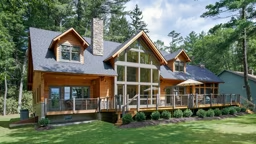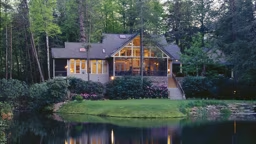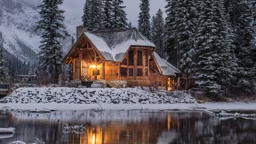Log, timber and hybrid homes are uniquely designed, so whether you’re building new, adding on or restoring, these one-of-a-kind structures sometimes call for equally unique heating and cooling solutions. These alternative systems offer creative ways to stay comfortable — physically and financially.

Electric Panel Wall Heaters
What it is: A simple solution for spaces that just need a little heating boost. Think: a drafty, partially finished basement, an addition or an accessory dwelling unit. Easy to install, a panel wall heater is akin to a portable space heater, just permanent and potentially more powerful.
Start shopping: The Envi line of wall-mounted electric panel heaters from eheat, Inc. are designed and built in the USA, and with prices starting at $180, are an affordable way to add heat now. The EnviMAX can warm rooms up to 350 square feet, and the Smart Envi is compatible with Amazon Alexa and Google Home, so you can set your heating to your schedule.
_11868_2024-08-09_08-08.jpg)
Geothermal Heat Pumps
What it is: Geothermal systems capitalize on the fairly consistent temperatures found within the earth. Through a system of connected pipes, a geothermal heat pump circulates water or air beneath the surface and up into a heat pump, where it’s transferred to a traditional forced-air system and/or radiant in-floor system. These can be designed for new builds or retroactively added to existing homes.
Start planning: A geothermal system is ultra-efficient and will allow you to save on energy costs over the life of your home. However, it will come with some serious up-front costs associated with the excavation and pipelines necessary to set it up.

Small-Duct High-Velocity Systems
What it is: Small-duct high-velocity (SDHV) heating and cooling systems use small, flexible ducts to move warm and cool air around your home at high speed. Combined with unobtrusive registers, these systems take up less space in new builds and are easier to retrofit into older homes. They also have less surface area for thermal loss.
Start Shopping: The Unico System boasts all the benefits of design flexibility as well as remarkably quiet performance and distinctly draft-free delivery, thanks to “aspiration” and advanced humidity management.

Radiant Floors
What it is: Radiant in-floor heating can take a variety of forms, from a hydronic system in which water circulates through pipes, to an electric system, wherein a network of cables generates heat under the floors. It’s undeniably cozy, but it also comes with a host of other benefits. For example, these systems make a lot of sense for individuals with allergies or respiratory sensitivity, as you can warm your space without blowing air — and all the allergens in it — around.
Start planning: If you’re building a new home, involve your team as early as possible so you can optimize your home’s plan as well as your material selections. When it comes to flooring, you can install radiant systems under nearly any material, e.g., wood, vinyl, linoleum or carpet. Concrete and ceramic are particularly popular choices thanks to their ability to store and radiate heat.











